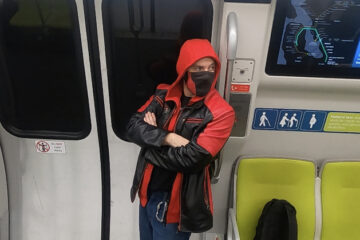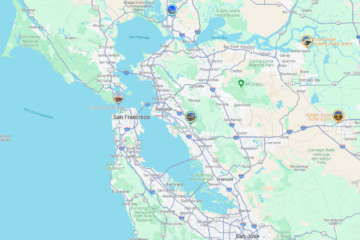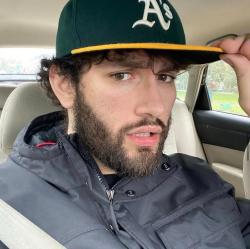To Understand the East Bay, You Must First Understand San Pablo Avenue
The East Bay is nearly impossible to define as a whole. It’s a sprawling, urban area that includes two counties, two area codes and a population of over 2.7 million people. There is no one neighborhood or city that truly can encompass everything that the East Bay is. But there is one street that seems to guide you through the East Bay’s many shifting realities: San Pablo Avenue.
From the densely urban neighborhoods of Oakland and Berkeley, to the gritty, industrial swaths of Richmond, to the spread out suburbia of Pinole and Hercules and the small company towns of Rodeo and Crockett, San Pablo Avenue is the common link that all of these communities share.
Starting at the northern end of San Pablo Ave is the small town of Crockett. Crockett was built around the C&H sugar factory, and has an architectural style that is reminiscent of Sausalito. One of the main attractions in Crockett is the Dead Fish, an upscale, waterside restaurant with views of the Carquinez Strait, the Napa River, San Pablo Bay; as well as views of Mare Island, Vallejo and Benicia directly across the bridge. Crockett also has some local fame as the hometown of Alfred Zampa, a legendary iron worker, who, during his career, worked on many of the Bay Area’s bridges, including the Golden Gate Bridge, which he fell off of and miraculously survived. As a result of his larger than life legend, the Carquinez Bridge is also known a the “Al Zampa Bridge.”
As you continue southbound on San Pablo Avenue, you’ll hit another historic town: Rodeo. Rodeo is home to the Phillips 66 San Francisco Bay refinery, which isn’t necessarily a good thing from an environmental standpoint, but it does provide tax revenue and jobs to Contra Costa County. Despite being only 15 miles north of Berkeley, Rodeo feels a world away. It has the vibe of a Midwestern, industrial town. One connection that Rodeo does have with its politically inclined neighbor to the south is music. Green Day is often heralded as a quintessential part of Berkeley’s music history, and this is indeed true. Green Day made its mark on the East Bay Punk scene and later the mainstream music world as a result of their involvement in Berkeley’s 924 Gilman Street punk club, but for two of the three members of Green Day (Billie Joe Armstrong and Mike Dirnt) their roots are in Rodeo.
The next town you’ll encounter is Hercules. While Hercules’ next door neighbor, Rodeo is a blue collar, refinery town. Hercules is every example of modern, master-planned suburbia. The streets are perfectly paved, people are reserved, but friendly enough; crime is low and schools are above average. The town started off similarly to Rodeo, as a company town, rather than an oil refinery, it was situated around an explosives and munitions manufacturer called The Hercules Powder Company. As a result, people colloquially called the area Hercules, after the Powder Company. Once the city was incorporated, no one could really come up with anything, so the name stuck. Although, it’s hard to see any evidence of its industrial past as you cruise down San Pablo Ave through Hercules today.
Directly south of Hercules is Pinole. Pinole is a mixture of old and new. You have the strip malls and big, boxxy suburban homes you see in Hercules, mixed in with older homes that go as far back as the 1800s. A friend from the area described Pinole as “the place people from Richmond move to for a better life.” I know don’t know if that’s true or not, but when exploring Pinole, you do see a lot of bored teenagers, and isn’t boredom the epitome of suburban paradise?

The San Pablo city arch (Photo Courtesy of San Pablo’s city government website)
Next up is San Pablo. San Pablo is a weird place. It doesn’t really have an identity. It’s a city in the middle of other cities, and it tends to blend in with whatever it happens to be bordering. The parts of San Pablo that border Richmond are pretty much indistinguishable from Richmond, the part that borders Pinole looks like an extension of Pinole — as you head toward the part that borders El Sobrante, the lots get bigger, and you also have a higher likelihood of seeing middle-aged biker types whose midlife crisis has manifested itself through faux-masculine posturing and confederate flag waving, mixed awkwardly with an affinity for Bay Area Hip Hop culture circa 1995. Gotta love that El Sob influence.
Once you pass San Pablo, you hit Richmond. Richmond is a sprawling city of extreme contrasts. It’s where the East Bay’s urban corridor and industrial corridor meet. It has the lowest percentage of white residents of any Bay Area city. That’s because after World War 2, white people fled Richmond for the newly created suburbs up the bay (Pinole, Hercules) or on the other side of the hill in the East Bay’s valleys (Walnut Creek, Concord.) Minorities weren’t allowed in these new cities at the time, and when the white population left, so did a good amount of the area’s tax revenue. Not only that, when the war ended, a lot of the jobs that the newly formed black community relied upon left shortly after.
Another factor that deterred people from living in Richmond was the Chevron Refinery. It’s the largest refinery in the Bay Area, and has had major scandals over the years, including a recent refinery fire in 2012 that sent smoke billowing over much the of the San Francisco Bay and San Pablo Bay. However, in recent years, things are starting to get better in Richmond. Homicides are way down, Chevron, which used to have a stranglehold on Richmond’s local politics, is starting to lose their grip, and progressive political organizations have grown immensely in Richmond. With these improvements, fear of gentrification looms over the city, but has yet to take place. People expect the first wave of gentrification after ferry service to San Francisco begins on Richmond’s southwestern shoreline, but we’ll have to wait and see if this actually happens. I find the anxiety around the ferry to be unfounded, considering Richmond is in proximity to 3 Bart stations, as well as an Amtrak station. It’s not like public transportation in Richmond is a new thing.
Next stop on the San Pablo Ave adventure is El Cerrito. El Cerrito, while it is its own city, functions as Richmond’s equivalent to the Oakland Hills. While Richmond is minority-majority and largely working class, El Cerrito is upper middle class and majority white. If you turn off San Pablo Avenue to go up into the El Cerrito portion of the East Bay hills, you get views of the San Francisco skyline, the Golden Gate Bridge and panoramic views of the Bay. El Cerrito has some interesting history if you’re into Metal Music. Metallica shared a home in El Cerrito in the 80s.
As you exit Contra Costa County, and continue down San Pablo Ave from El Cerrito, you enter Alameda County and the city of Albany. Considering Albany shares a border with Berkeley to the south, it’s actually very quiet. I hate when people describe an area as “cute,” but the description kinda fits Albany. You can go into cafes and hear women in their 60s talk about their “crazy years in Berkeley.” It seems to be the place where educated radicals go to retire, but can still be a short distance to the next protest, should they feel the need to “fight the power.” There’s also a pub dedicated to smoking cigarettes outside, and where the fuck can you find that anywhere else in the Bay Area nowadays?
As you continue wandering south on San Pablo Ave, you’ll see Albany seamlessly merge into our next city: Berkeley. Berkeley is famous for being California’s most liberal city, as well as being home to the top public university in the world, UC Berkeley. Berkeley is predictable in its unpredictability. You may see nude people smoking weed at a bus stop, or gutter punks playing shitty folk punk on their guitar, cursing their parents for being fascist. It’s all here. Berkeley is the city where the world’s most brilliant minds intersect with society’s most delusional. The thing is, there’s a beauty to Berkeley’s absurdity. While Berkeley may come off idiotic, deep down, it’s just trying to do what’s right, even if it struggles with how.
As you leave Berkeley, before you know it, you’re in Emeryville. Emeryville is basically a neighborhood that functions as a city because it couldn’t figure out if it was South Berkeley or North Oakland. There’s a lot of luxury condos and retail here. That’s about it. I’m sorry.
The last city San Pablo Ave will take you to is Oakland. Radical politics in Berkeley have always felt like a youthful phase, but in Oakland, it’s a way of life. The reason behind this is that the oppression in Oakland is actually based in experience, not research. Oakland is the third most diverse city in the United States. Despite this fact, Oakland is not the dream Martin Luther King probably had in mind. It’s a place where your quality of life is largely determined by your zip code. Wealthy children wake up in the hills to the sound of birds chirping, while poor kids in the flat lands have their sleep disturbed by the sound of gunfire. Oakland is fucked up, but it’s also beautiful. There’s a unique vibe in Oakland that can’t be overlooked. There’s so much art and creativity on display, it’s easy to be overwhelmed. There’s a lot of wealth, a lot of poverty and more personality than one can really comprehend without actually stepping foot in “The Town.” A lot of people compare Oakland to Brooklyn, but I disagree because I don’t think Oakland can be compared to anywhere. Oakland is Oakland, and Oakland is proud.
San Pablo Avenue isn’t only a street, it’s a symbol. Despite how different we may appear, we’re all connected, one way or another.





















